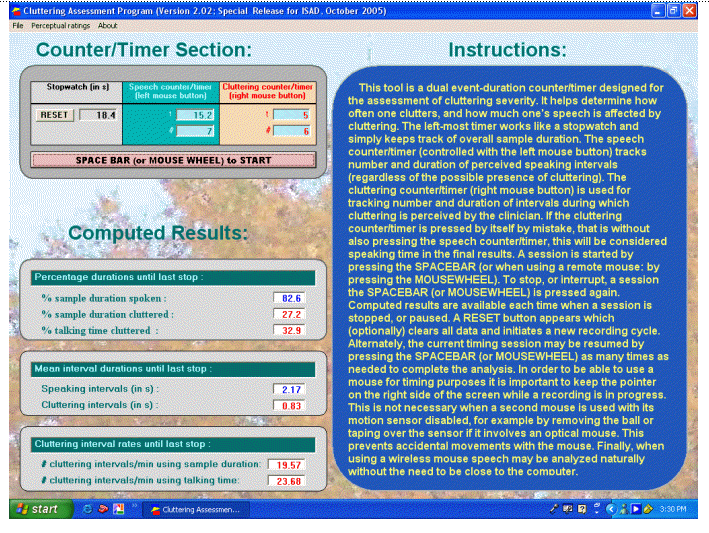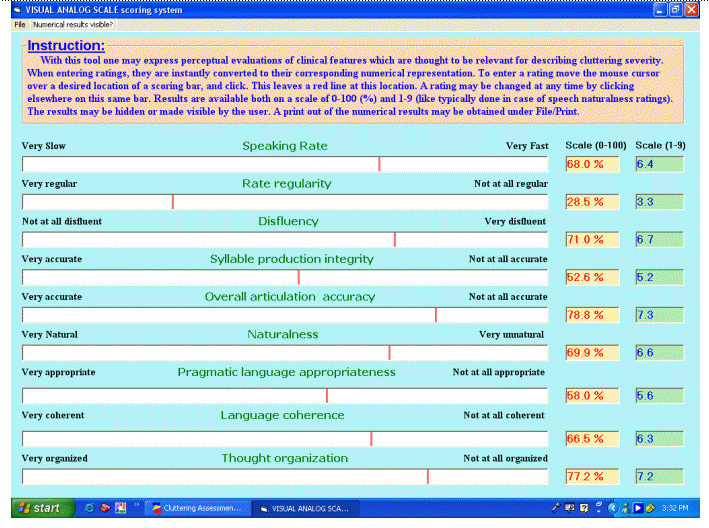Computer-Based Cluttering Assessment Tool (Clasp)
 |
About the presenters: Klaas Bakker, associated with Missouri State University since 1990; specializes in fluency disorders; research focus on fluency disorders (assessment and diagnostic evaluation of cluttering and stuttering); develops new technologies for the assessment and measurement of clinical aspects of speech (dys)fluency; Associate Editor for the Journal of Fluency Disorders; Chair of the Taskforce on Technology of Special Interest Division 4 (Fluency and Fluency Disorders). |
 |
Kenneth O. St. Louis, associated with West Virginia University since 1976; also specializes in fluency disorders (especially cluttering, stories of those who stutter or clutter, and worldwide public attitudes toward stuttering); National Stuttering Association chapter founder/leader; former Associate Editor for Journal of Fluency Disorders and former president of the International Fluency Association. |
 |
Florence L. Myers has presented a number of papers on fluency disorders. She has (co)authored books, book chapters and journal articles on cluttering. She is a former Associate Editor of the Journal of Fluency Disorders. She is Professor at Adelphi University in Garden City, New York. |
 |
Lawrence J. Raphael was educated at the City University of NY. He teaches Communication Science at Adelphi University. He was a research associate at Haskins Laboratories for 26 years. His research appears in several journals. He is a co-author of Speech Science Primer and co-editor of Producing Speech. He is a Fellow of the New York Academy of Sciences. |
Computer Aided Assessment of Cluttering Severity*
by Klaas Bakker ( Missouri, USA), Kenneth O. St. Louis (West Virginia, USA) and Florence Myers and Lawrence J. Raphael (New York, USA)
Abstract
Cluttering, a fluency disorder which gained much interest recently, is in need of procedures for treatment evaluation, as well as empirical clinical research. No assessment tool exists for addressing cluttering severity specifically. This presentation reviews and demonstrates the features of a newly developed computerized cluttering assessment system. One option provided by the program involves online quantified assessment (e. g., percentage talking time cluttered). The second option collects a user's perceptual ratings (visual analog scale response format) with regard to features thought to be relevant for a qualitative description of cluttering severity of one's client.
Introduction:
Cluttering is a puzzling fluency disorder which has recently gained much interest in our specialization. It has been defined as "...a fluency disorder characterized by a rate that is perceived to be abnormally rapid, irregular, or both for the speaker (although measured syllable rates may not exceed normal limits). These rate abnormalities further are manifest in: (1) an excessive number of disfluencies, the majority of which are not typical of people who stutter; (2) the frequent placement of pauses and use of prosodic patterns that do not conform to syntactic and semantic constraints; and/ or (3) inappropriate (usually excessive) degrees of coarticulation among sounds, especially in multisyllabic words." (St Louis, Myers, Bakker & Raphael, In Press). Only a few empirical studies of cluttering have been ever conducted, as much of the literature has been based on anecdotal and clinical accounts (Curlee, 1996). As clinicians are now more likely to identify cluttering in their caseload than before, there is the need for controlled empirical clinical research in this area. This -- as well as the treatment of cluttering -- has created the need for assessment tools with promising features of validity, reliability and feasibility for use by mainstream clinicians.
Some protocols exist for diagnostically differentiating cluttering from stuttering (e. g., Daly, 1993). However, no commonly agreed procedures exist for measuring cluttering severity. Clearly, in order to establish treatment efficacy and effectiveness of intervention, quantified assessment of cluttering severity is needed, with procedures that have effective and promising psychometric features. This presentation is designed to make such a tool available to potential users.
Cluttering, unlike stuttering, does not manifest itself in a consistent form. That is, given the multifaceted and complex nature of cluttering, the Cluttering Assessment Program serves as a unique and needed assessment tool as no single molecular assessment (e. g., frequency count of disfluencies) is likely to capture the overall severity of cluttering. Because of the nature of a cluttering problem its assessment can be challenging while distinctions between cluttered and "normal" speech can be blurry at times. Any approach that requires counting or timing of specific instances of predefined speech characteristics does not seem a feasible approach in the case of cluttering. Therefore, the Cluttering Assessment Program assesses cluttering through perceptual methodologies. It presents a semi-quantified procedure that promises to facilitate systematic assessment of cluttering severity (e.g., for determining baselines, treatment effect, and evaluations regarding treatment termination). The instrument supports two perceptual scoring strategies: (a) a "molar" perceptually based severity rating (based on the determination of percentage talking time cluttered), as well as (b) a set of visual analog scoring scales reflecting dimensions described as relevant for depicting the essence of cluttering in previous literature (St. Louis, Myers, Faragasso, Townsend, & Gallaher, 2004), such as: speaking rate, rate regularity, disfluency, syllable production integrity, overall articulation accuracy, naturalness, pragmatic language appropriateness, language coherence, thought organization.
The purpose of this presentation is to discuss, demonstrate, and make available a software tool for the perceptual assessment of aspects of cluttering severity. While immediately helpful in assessing cluttering severity in one's clients, the tool is also slated to be researched in the light of possible adoption as an assessment instrument in support of evidence based practice.
The Program:
The quantified assessment portion:
This tool consists of a dual event-duration counter/timer designed for the assessment of frequency and duration related aspects of cluttering severity. It helps determine how often one clutters, and to what degree one's speech is affected by cluttering in a durational sense. In addition to these counter/timers is a third timer which works like a stopwatch (left-most timer in Figure 1) and reflects overall sample duration. The middle counter/timer (controlled with the left mouse button) tracks number and duration of speaking intervals (regardless if cluttering is present or absent from the sample). A third counter/timer (right mouse button) is used for tracking number and durations of intervals during which cluttering is perceived by the clinician. If the cluttering counter/timer is pressed by itself by mistake, without also pressing the speech counter/timer, this will be automatically considered speaking time in the calculations as well. A session is typically started by pressing the SPACEBAR (or when using remote scoring: by pressing the MOUSEWHEEL). To stop, or interrupt, a session the SPACEBAR (or MOUSEWHEEL) is pressed again.
Computed results are available each time when a session is stopped, or paused. A RESET button appears which (optionally) clears all data and initiates a new recording cycle. Alternately, the current timing session may be resumed by pressing the SPACEBAR (or MOUSEWHEEL) as many times as needed to complete an analysis. In order to be able to use a mouse for timing purposes it is important to keep the pointer on the right side of the screen while a recording is in progress in order to prevent accidental clicks on the program controls. This is not necessary when a second mouse is used with its motion sensor disabled, for example by removing the ball (old system) or taping over the sensor if it involves an optical mouse. This prevents accidental movements with the mouse over the program controls and production of spurious data. Finally, when using a wireless mouse, cluttered speech may be analyzed naturally without being influenced by the presence of a computer. Remote scoring using a wireless mouse may have limitations in terms of distance due to design or power left in the battery.
The qualitative assessment portion
The visual analog scoring portion of the program allows a user to provide ratings on the following dimensions of cluttering: speaking rate, rate regularity, disfluency, syllable production integrity, overall articulation accuracy, naturalness, pragmatic language appropriateness, language coherence, and thought organization. As can be seen in Figure 2 the procedure expects the user to mark a rating by clicking at the appropriate part of a scoring bar. This leaves a mark that may still be adjusted by clicking at a new location if so desired. After a rating is provided the computer calculates the percentage that corresponds with the relative location of the mark on the scoring bar. At the same time this score is recalculated to match the 9-point rating procedure such as typically used in speech naturalness ratings (that is, a perceptual rating scale with 1 as the most natural and 9 as the least naturally sounding speech). Some users may wish to hide these numbers when they are providing their ratings in order to make the procedure as similar as possible to the familiar paper-scored analog process. The program contains an option for printing results, both for the quantified and qualitative assessment portions.
It is hoped that the aforementioned system will stimulate empirical clinical research demonstrating its features of validity, reliability, as well as feasibility for use by main stream clinicians who need to assess cluttering severity. The system is freeware, which means that there are no restrictions to disseminating it among any interested users.
Figure 1. Example of the quantified scoring tool, with online cluttering severity ratings, among which the percent talking time cluttered discussed in the text.

Figure 2. The qualitative portion of the program featuring visual analog rating scales for the assessment of cluttering severity.

The Cluttering Assessment Program is compatible with any PC with a recent version of Windows. (It is not Macintosh compatible). The computer screen should be set at XVGA (or 1024*768) for optimal functioning. There are no specific requirements for storage space or memory as it involves a small program that will not have to remember very much during its processing! A printer is helpful for printing out the results.
Download the freely-available program here
Some users, especially those who have not downloaded much software before, may get the message that the file 'comdlg32.ocx' is missing. After downloading it and saving it in the c:\windows\system32 directory the program should work for them as well.
The missing file is available from: http://www.snapfiles.com/help/missingfiles.html
Directly below the first example, underneath the red letters "What's up next? is a link for downloading the file.
NOTE: A more recent version of the Cluttering Assessment Program (Version 2.02) is available HERE
* Components of the Cluttering Assessment Program were previously demonstrated as parts of a double mini seminar at the National Annual Convention of ASHA (Myers, St. Louis, Bakker, Raphael, Wiig, Katz, Daly, & Kent, 2002 a, b). The present version of the program is a fully functional, stand alone, application emphasizing the features that are most likely needed in the diagnostic evaluations and the treatment evaluation regarding the intervention of possible cluttering.
References
Curlee, R. (1996). Cluttering: Data in search of understanding. Journal of Fluency Disorders, 21, 367-371.
Daly, D. (1993) Daly's Checklist for Possible Cluttering: Some Clarification, The Clinical Connection, 8-9.
Myers, F. L., St. Louis, K. O., Bakker, K., Raphael, L. J., Wiig, E. K., Katz, J., Daly, D. A., & Kent, R. D. (2002a). Putting cluttering on the map: Looking ahead. Seminar presented at the Annual Convention of the American Speech-Language-Hearing Association, Atlanta, GA.
Myers, F. L., St. Louis, K. O., Bakker, K., Raphael, L. J., Wiig, E. K., Katz, J., Daly, D. A., & Kent, R. D. (2002b). Putting cluttering on the map: Looking back. Seminar presented at the Annual Convention of the American Speech-Language-Hearing Association, Atlanta, GA.
St. Louis. K. O., Myers, F. L., Faragasso, K., Townsend, P. S., & Gallaher, A. J. (2004). Perceptual aspects of cluttered speech. Journal of Fluency Disorders, 29, 213-235.
St. Louis, K. O., Myers, F. M., Bakker, K., & Raphael, L. J. (In press). Understanding and treating cluttering. In R. F. Curlee & E. G. Conture (Eds.) Stuttering and related disorders of fluency, 3rd ed. NY: Thieme.
St. Louis, K. O., Raphael, L. J., Myers, F. L., & Bakker, K. (2003, November). Cluttering updated. The Asha Leader, 8-21, 4-5 & 20-23.

